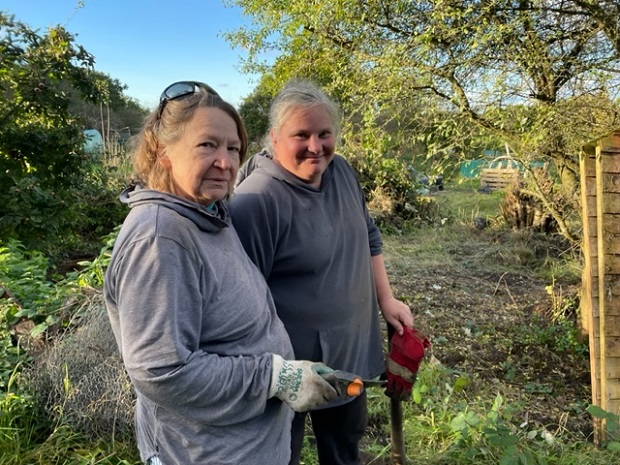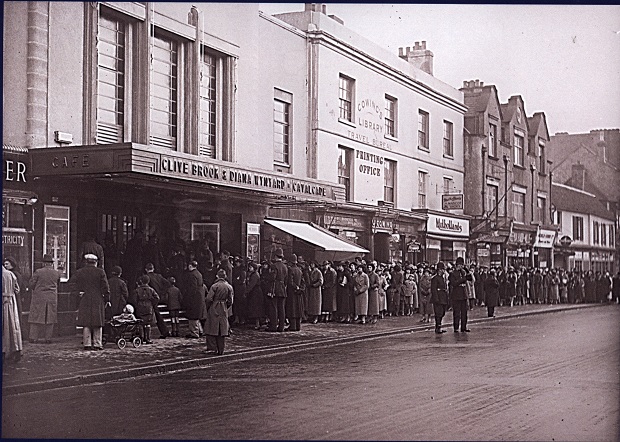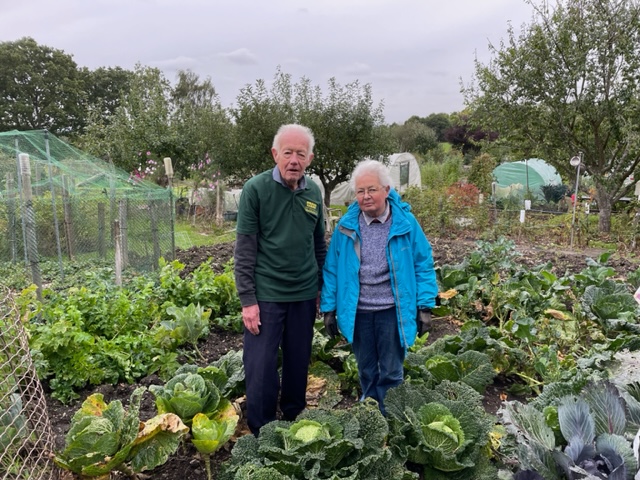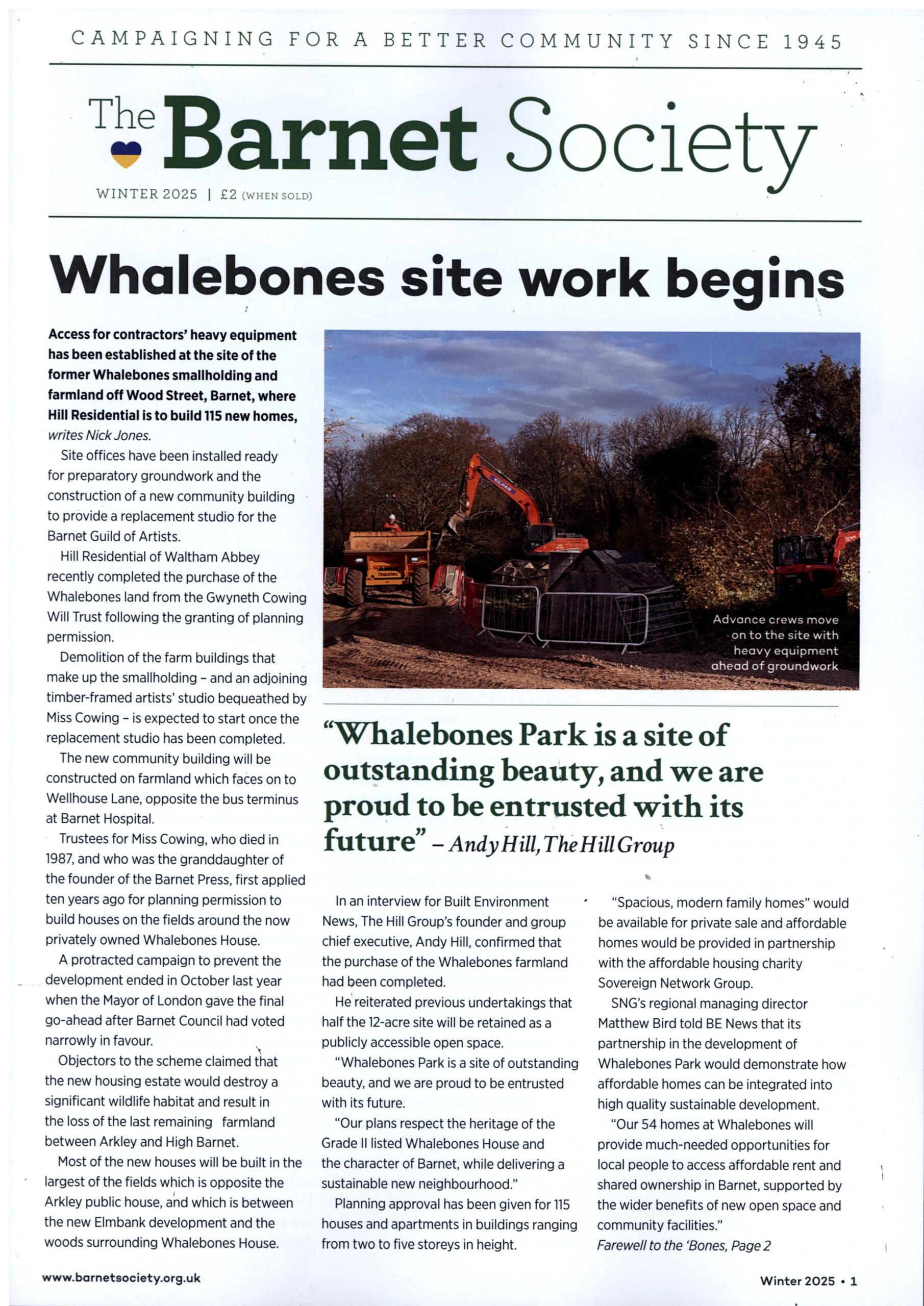Wartime Dig for Victory campaign to be remembered at 85th anniversary of High Barnet’s Byng Road allotments

High Banet’s popular Byng Road allotments owe their existence to the Dig for Victory campaign at the start of World War II which encouraged the home cultivation of fruit and vegetables.
Plot holders at Byng Road became a force to be reckoned with — their site was one of the first wartime allotments to get approval in October 1939 and it is one of a select few to remain in cultivation.
Half a million wartime allotment sites were reclaimed by local authorities for housing, parks and other uses, but such was the local demand for plots that by the 1950s the group was allocated a permanent location beside what are now the Byng Road playing fields.
To commemorate their 85th anniversary in October, Anna Robins, chair of the allotment group (above, right) has written a history of the Byng Road site and its continuing success, despite a fluctuating demand for land for home cultivation.
With Anna is former group secretary, Erica McCormick, who saw through the final step towards establishing an association to take over day-to-day control of the site from Barnet Council.
When World War II was declared in September 1939 the government launched its Grow More Food campaign which became known as Dig for Victory – a phrase coined by the late Michael Foot, then a journalist at the Evening Standard.
Barnet Urban District Council acted promptly after having received within a matter of days 30 applications for plots for wartime cultivation, far too many to be accommodated at the existing Bells Hill allotments.
A list of possible sites for cultivation included land in Dollis Valley off Mays Lane, Barnet Lane, and Longland Drive, and a site off Chesterfield Road.
A fifth site proposed was a portion of land off Byng Road which Hertfordshire County Council had purchased for school playing fields where there was space for 400 plots of ten poles each (each plot is just over 300 square yards).
Barnet UDC negotiated terms to lease the site. By December 1939, 28 ten pole plots had been pegged out and 19 were already let.
Such was the enthusiasm generated by the Dig for Victory campaign, that the urban council’s allotments committee arranged for a speaker from the Hertfordshire Institute of Agricultural to address the next meeting of the wartime allotments holders.

It was held at the Barnet Cinema cafe in January 1940 and on the agenda was a discussion about cultivation, the cooperative purchase of seed potatoes and the formation of an allotment holders’ association.
(Barnet Cinema, which was in the High Street, next to Cowing’s printing works and the Barnet Press, was renamed the Gaumont in 1955 and was closed by the Rank Organisation in 1959).
The first year of cultivation at Byng Road was not without incident. In October 1940, high explosive bombs were dropped on the allotment site which are said to be reason why plots near the western boundary are particularly stoney and some were never cultivated.
Within a year of the creation of Byng Road allotments, the urban council approved further sites including plots at Barnet Barracks, Hadley Manor estate, Valley View and Chesterfield Road.
By the end of World War II, although by then the Byng Road allotments had 35 vacancies, the government continued to urge local authorities to encourage home cultivation and the site was designated as a statutory allotment in June 1947, placing it on a permanent basis.
Minutes of the council’s allotments committee reveal the ups and downs at Byng Road. In 1949 one tenant was issued with a notice to quit because the plot was overgrowth with weeds.
In 1950 the site was finally given its own water supply. After a request for access to the site from Old Fold View, a footpath was installed between the playing field of Queen Elizabeth’s Boys’ School and what is now Noah’s Ark Children’s Hospice.
The mid-1950s heralded another milestone in the history of Byng Road allotments.
Hertfordshire County Council had been anxious for some time to reclaim the original allotment site of 88 plots (in the field next to Noah’s Ark) to provide a playing a field for what was then the Byng Road Secondary School.
The two authorities agreed that the allotments should be relocated to an adjoining site which is next to what is now the playing field of Barnet Elizabethans Rugby Club.
It cost £1,140 to develop the site with a total of 79 plots – 62 ten pole plots and 17 five pole plots.
The first tenants were Edward and Hilary Eyre who said that in 1952, when they moved across to the newly approved site, there was no water supply, sheds were not allowed, and only vegetables could be grown.

For the last 67 years, Peter Morris has been tending his allotment with the same determination and enthusiasm since he took on his first plot at Byng Road in 1956 at the age of 15.
Peter, who is now 82 – seen above with his sister Angela – had to ask his grandmother Edith to be his guarantor because he was under 21. He signed up for a ten-pole plot at a rent of 10 shillings and 6 pence a year.
Instead of doing a paper round as a schoolboy, he had begun growing plants at home and was keen to start cultivating vegetables when the chance came up to rent a plot.
Even though food rationing had ended in 1955 the year before Peter got his plot, many families still relied on their allotments.
Peter remembers how in the late 1950s and early 1960s some of the Byng Road plots were cultivated by men who travelled out from London.
“At weekends some of them came for the day, on the tube from Highgate, Kentish Town, Camden Town and even Angel, with their spades, forks, and a packed lunch. Some had a Primus in their sheds, so they could brew a cup of tea.”
Peter’s dedication to the Byng Road Allotments knew no bounds: he became honorary secretary of the allotment group in the 1960s, a post he filled for over 30 years, with the assistance of his sister Angela.
On Peter’s initiative the allotment group took the first step towards self-control of their site when, in 1980, in return for a substantial discount for plot holders, he reached an agreement with Barnet Council to collect the annual rents himself, thus saving the council the cost of paperwork and postage.
He was proud of the deal he had secured for the Byng Road allotees giving them the “cheapest allotment rents” in the area.
When Peter stood down in 2001 – and handed over the role of secretary to Erica McCormick – he reflected on all the “fun and friendship and happiness” he had experienced at the Byng Road site since taking on a plot in the 1950s when still a schoolboy.

